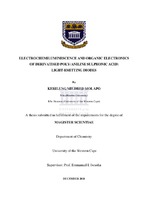| dc.description.abstract | Applications of electrochemiluminescent conjugated polymers offer promising solutions in addressing the problem of light emitting devices. However, the challenging problems that hamper their application in light emitting devices are loss of signal due to diffusion of the electrochemiluminescence (ECL) reagent out of the detection zone, limited ability to repeatedly cycle an individual luminophore and high reagent consumption. In this work, the main objective was to produce conducting polymers with enhanced electrochemiluminescence by tuning the properties of the polymer itself. The electrochemical and photophysical properties of films of polyaniline (PANI) and poly(8-anilino-1- naphthalene sulfonic acids) (PANSA) synthesized through electro- and chemical polymerization methods were also investigated. The electrosynthesis of PANSA undoped and doped with anthracene sulfonic acid (ASA), 1,2-naphthaquinone-4-sulfonic acid (NSA) and carbon nanotubes (CNT) in acid medium was investigated and the cyclic voltammograms (CV) showed the growth of the polymer during polymerization. The CV multiscan characterization displayed that the growth of the polymer was dependent of the scan rate and the three redox couples were observed as indicative of the three redox states of typical polyaniline and its derivatives. The results also showed that the peak currents were diffusion controlled and the electron charge transport coefficient (De) of the electrosynthesized polymers was found to range between 10⁻⁸ and 10⁻⁹ cm² s⁻¹ for PANSA, PANSA-ASA, PANSA-NSA and PANSA-CNT. The De value indicates that the movement of electrons along the polymer chain was averagely fast. The transmission electron microscopy (TEM) was used to investigate the electronic morphology of the polymers and the TEM images showed an intertwinement of tubings which aggregate into a ring with a mixture of tubings and plastic sheets. The chemical synthesis of PANI, PANSA and PANI-NSA was carried out by using monomers analine, 8-anilino-1-naphthalene sulfonic acid, and aniline with 1,2- naphthaquinone-4-sulfonic acid, respectively, using oxidants. All chemically synthesized polymers exhibited quinoid and benzoid bands typically see in polyaniline FTIR and Raman spectra confirmed the successfully formation of polymers. The CV characterization of these polymers showed distinctive redox peaks. This proved that the polymers were electroactive, conductive and exhibited reversible electrochemistry. The De of the electrosynthesized polymers was found to be ~10⁻⁵ cm² s⁻¹ for chemically synthesized polymers. The electric conductivity measurement showed to increase from 10⁻⁴ to 10⁻² when aniline was polymerized with NSA dopant, this might be related to the process of electron transfer from dopant to polymer. Scanning electron microscopy for external morphology showed that the polymers were made of different nano- rods polymeric structures.
Photophysical properties of electro- and chemically synthesized PANSA and PANI were investigated through UV-vis absorption, fluorescence behaviour, and lifetime. The UV-vis absorption spectra of these polymers showed that they exhibited absorption bands corresponding to the polyemeraldine redox state of typical polyaniline. The effect of dopants resulted in the increase in solubility of the polymers with a small shift of absorption bands due to incorporation of dopants in to the backbone of the polymer. The fluorescence emission spectra of the electrochemically synthesized PANSA with and without dopants were observed to be similar and mirror image of the excitation spectra and corresponding to the electronic band of the benzoid ring in the polyemeraldine form confirming that the fluorescing molecule in these polymers were the benzoid rings. However, the emission spectra of the chemically synthesized PANSA and PANI were different to excitation spectra due to loss of symmetry upon excitation. The effects of chemically synthesized PANI, PANSA and PANI-NSA addition on the photophysical properties of [Ru(bpy)₂(picCOOH)]²⁺.(ClO₄⁻)₂) were investigated in order to understand the interaction of polymer and [Ru(bpy)₂(picCOOH)]²⁺.(ClO₄⁻)₂. The analysis revealed that the presence of polyaniline and its derivatives enhanced the [Ru(bpy)₂(picCOOH)]²⁺.(ClO₄⁻)2 absorption band, photoluminescence and fluorescence lifetime. The enhancement observed from interaction of [Ru(bpy)₂(picCOOH)]²⁺.(ClO₄⁻)₂ with polyaniline and its derivatives might be due to the excited state electron transfer from the PANI and PANSA excited state to the [Ru(bpy)₂(picCOOH)]²⁺.(ClO₄⁻)₂. It was further demonstrated in this work that it is possible to form polyaniline and PANSA doped with [Ru(bpy)₂(picCOOH)]²⁺.(ClO₄⁻)₂ films on ITO electrode using potentiostatic growth method to favour ECL production. The results showed that all films generated ECL in the presence of Tripropylamine (TPA) as a co-reactant and their emission properties depend on time used to prepare the film. The enhancement of ECL signal was due to a positive electron transfer from the conducting polymer (PANI and PANSA) to [Ru(bpy)₂(picCOOH)]²⁺.(ClO₄⁻)₂ complex. The results highlighted the potential of these polymeric luminophores usage in the manufacturing of the ECL devices. | en_US |

